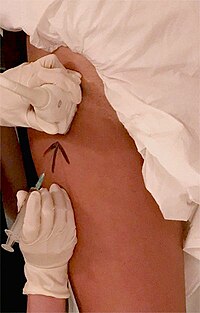
Photo from wikipedia
BACKGROUND Ankle osteoarthritis (OA) is painful and can impact a patient's physical and mental quality of life. Although intra-articular injections are commonly used to alleviate symptoms, there is conflicting evidence… Click to show full abstract
BACKGROUND Ankle osteoarthritis (OA) is painful and can impact a patient's physical and mental quality of life. Although intra-articular injections are commonly used to alleviate symptoms, there is conflicting evidence concerning their efficacy. Therefore, an updated systematic review would be informative. QUESTION/PURPOSE In this systematic review, we asked: Are there clinically important benefits or harms associated with the use of intra-articular injections in the treatment of ankle OA? METHODS We used PubMed, Embase, and the Cochrane Library to search for randomized controlled trials on intra-articular injections for the treatment of ankle OA in June 2021, and updated the search in January 2022; eligible dates were from the date of inception of each database through January 2022. Reference lists of eligible studies and previous reviews were manually screened. Two reviewers independently assessed studies for eligibility. We included seven studies. Three compared hyaluronic acid (HA) with saline, one compared HA with exercise, one compared four different regimens of HA [34], one compared platelet-rich plasma (PRP) with saline, and one compared botulinum toxin Type A (BoNT-A) with HA. A total of 340 patients were included: 141 in the HA arms, 48 in the PRP arm, 38 in the BoNT-A arm, and 113 in the saline arms. Across all studies, the mean age was 52 ± 21 years, and 35% were women (119 of 340 patients). Methodologic quality was assessed using the Cochrane Risk of Bias 2.0 tool. Of the included studies, the risk of bias was low in two studies, presented some concerns in one study, and was high in four studies. According to the Grading of Recommendations Assessment, Development, and Evaluation methodology, the level of evidence was very low for HA, moderate for PRP, and very low for BoNT-A. The level of heterogeneity was high, and we opted to perform a systematic review rather than a meta-analysis. A clinically relevant difference was based on whether the between-group difference surpassed the cutoff point determined as the minimum clinically important difference. RESULTS No clinically relevant differences were found among HA, PRP, and BoNT-A and their control groups at 3, 6, or 12 months. No studies reported any serious adverse events in any treatment group. CONCLUSION Given the lack of observed efficacy in this systematic review, these treatments should not be used in practice until or unless future high-quality studies find evidence of efficacy. LEVEL OF EVIDENCE Level III, therapeutic study.
Journal Title: Clinical orthopaedics and related research
Year Published: 2023
Link to full text (if available)
Share on Social Media: Sign Up to like & get
recommendations!